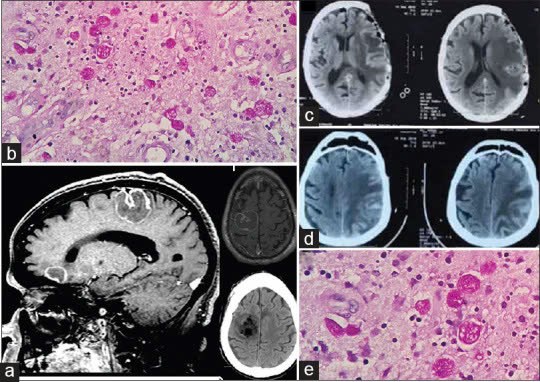Amoebic brain abscess is often confused with meningitis in its early stages, leading to incorrect treatment protocols. The mortality rate for patients with amoebic brain abscess is relatively high, and survivors often suffer severe long-term complications.
This condition is commonly found in tropical regions with hot, humid climates, poor sanitation, and limited socioeconomic conditions.
1. Causes of Amoebic Brain Abscess
Amoebic brain abscess is caused by the protozoan Entamoeba histolytica. Initially, when the body is infected with amoebae, characteristic ulcerative lesions form in the gastrointestinal mucosa, leading to dysentery.
If left untreated, the infection can spread. The amoebae enter the bloodstream from intestinal lesions, travel through the venous system, and eventually reach the brain. Once there, bacterial infection and pus formation create abscesses in locations such as the epidural space, subdural space, or within the brain tissue itself. Typically, the amoebae cause abscesses in both cerebral hemispheres.
Additional risk factors include:
-
Older adults (aged 60–70 years).
-
People living in unsanitary environments with poor food hygiene.
-
Women are at higher risk than men.
2. Symptoms of Amoebic Brain Abscess
Early-stage detection is difficult, and by the time symptoms appear, complications may already be life-threatening.
As the abscess develops over weeks, symptoms may include:
-
General discomfort and impaired reflexes, often leading to confusion.
-
Reduced motor function due to muscle weakness.
-
Nausea or vomiting.
-
High, persistent fever.
-
In infants: vomiting, excessive crying, bulging fontanelle, and limb stiffness.
-
Chills.
-
Blurred vision.
In severe cases, increased intracranial pressure can cause:
-
Intense headaches.
-
Vomiting and nausea.
-
Varying degrees of infection and toxicity.
-
Neurological symptoms depending on the abscess location.
3. Is Amoebic Brain Abscess Contagious?
Amoebic brain abscess is not transmitted from person to person. However, if someone in close contact (e.g., family members) has the condition, others should also be screened for amoebic infections.
4. Prevention of Amoebic Brain Abscess
Due to its severity, prevention is crucial. Key measures include:
-
Hand hygiene: Wash hands thoroughly with soap before eating and after using the toilet.
-
Safe farming practices: Avoid using untreated human waste as fertilizer.
-
Proper waste disposal: Prevent fecal contamination of water sources.
-
Food safety: Consume well-cooked food; avoid raw dishes like seafood salads. Wash vegetables thoroughly or use UV-treated water to eliminate amoebic cysts.
-
Prompt treatment: Individuals diagnosed with amoebic cysts must undergo complete treatment.
5. Treatment of Amoebic Brain Abscess
Amoebic brain abscess is life-threatening if not diagnosed and treated promptly. Treatment combines medical and surgical approaches, depending on factors such as the patient’s condition and disease progression. Early intervention minimizes complications.
Treatment methods include:
-
Anti-amoebic drugs to target the infection.
-
Pus drainage (aspiration or surgical drainage) if abscesses form.
-
Combination antibiotic therapy.
-
Surgery in cases of treatment failure, gas-forming abscesses, or risk of rupture leading to increased intracranial pressure.
-
Mechanical ventilation may be required for patients with coma, seizures, or airway obstruction.
Conclusion
Amoebic brain abscess is frequently misdiagnosed as meningitis early on, leading to improper treatment. The mortality rate is high, and survivors often face lasting neurological damage. Early diagnosis and treatment are critical for patient survival, though full recovery is rare.

